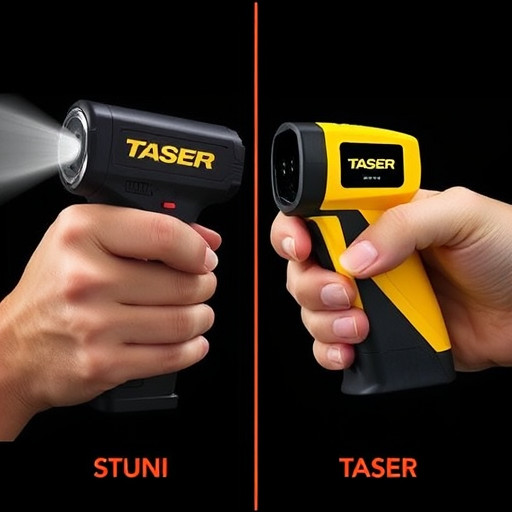Stun guns and tasers differ in their non-lethal force delivery methods: stun guns use metal prongs for direct skin contact, while tasers employ electrical probes that launch from a distance. Stun guns are simple to use with pressure-sensitive triggers, ideal for close encounters, while tasers require deliberate trigger pulls and safety switches, offering more versatile de-escalation options at a slightly longer range. Both require responsible storage, training, and maintenance according to manufacturer guidelines to ensure safe self-defense use, highlighting the unique features that make them distinct tools.
Uncover the distinct safety features that set stun guns and tasers apart in this comprehensive guide. Understanding these devices, particularly their differences, is crucial for informed decision-making regarding personal safety. From initial design to advanced mechanisms, we break down how each tool operates and where they excel. Learn about stun guns’ key safety features and tasers’ critical protection protocols. Discover when each is more suitable, and master best practices for safe use and storage, ensuring you’re prepared with the right self-defense choice.
Understanding Stun Guns and Tasers: A Basic Overview
Stun guns and tasers are both non-lethal weapons designed to incapacitate an opponent, but they operate on distinct principles. A stun gun delivers a powerful electrical shock through metal prongs or bars that make contact with the target’s skin. This jolt disrupts muscle control, causing the person to temporarily lose balance and become immobile. Stun guns are typically used by pressing them against the assailant’s body, ensuring direct contact between the device and the target.
In contrast, tasers use two fine probes connected to a gun-like device. When activated, the probes launch electrical charges at the intended subject, creating muscle contractions so intense they disable the individual. Tasers fire probes that travel several feet before adhering to their target, making them more versatile in close-quarters combat. Understanding these differences is crucial when considering which tool best suits an individual’s safety needs.
Key Safety Features of Stun Guns
Stun guns, also known as electroshock weapons, offer several key safety features distinct from tasers, highlighting their unique functionality in self-defense scenarios. One of the primary safety mechanisms is their non-lethal nature. Stun guns deliver a powerful electric shock designed to disable an assailant temporarily, without causing permanent harm or significant injuries. This makes them a preferred choice for personal protection, especially for individuals who want to incapacitate an attacker without resorting to deadly force.
Another crucial safety feature is their ease of use. Stun guns are typically designed with simplicity in mind, requiring minimal training to operate effectively. They often have straightforward activation mechanisms, such as pressure-sensitive triggers or simple switches, allowing users to deploy the device quickly during a threatening situation. This user-friendly design contrasts with tasers, which require more complex deployment techniques to ensure safe and effective use.
Critical Safety Mechanisms in Tasers
Tasers, unlike stun guns, possess unique safety mechanisms designed to minimize the risk of accidental discharge or misuse. One of the most critical is the trigger pull requirement, which demands a firm and deliberate action to deploy the device. This feature ensures that users must intentionally activate the taser, reducing the chances of unintended use. Additionally, tasers often incorporate safety switches or control buttons that further enhance user control, allowing for precise deployment in stressful situations.
These safety measures differentiate tasers from stun guns, which typically have simpler designs with less emphasis on such precautions. The difference between stun guns and tasers becomes evident in these critical safety mechanisms, underscoring the importance of understanding the unique features that set these devices apart before considering their use for personal protection.
Comparison: When is Each Device More Suitable?
When considering self-defense options, understanding the difference between a stun gun and a Taser is crucial. Stun guns deliver a powerful electrical shock that temporarily disables the target, causing muscle spasms and disorientation. They are typically designed for close-range use and are often preferred for personal defense due to their simplicity and reliability. On the other hand, Tasers (or Electronic Control Devices) fire two small probes connected to wires, delivering a high-voltage, low-current electrical pulse that disrupts the target’s neuromuscular system. Tasers are effective at a slightly longer range and are often employed by law enforcement for crowd control or in situations where a non-lethal force is required.
The choice between a stun gun and a Taser depends on various factors, including intended use, personal preference, and specific circumstances. Stun guns might be more suitable for close encounters where the user needs to quickly incapacitate an assailant without the need for distance or prolonged deployment. Tasers, with their ability to subdue targets at a bit more distance, are often preferred in scenarios requiring de-escalation tactics or when facing larger or better trained opponents.
Best Practices for Safe Use and Storage
When using either a stun gun or a Taser, adhering to best practices for safety is paramount. These devices should only be deployed as a last resort when facing an imminent threat to personal safety. Users must undergo proper training to understand the difference between stun guns and Tasers, their unique safety features, and how to effectively use them without causing unnecessary harm or injury.
Storage is another critical aspect. Both stun guns and Tasers should be kept in secure, childproof locations, away from prying eyes. It’s essential to follow manufacturer guidelines for charging and maintenance to ensure optimal performance and longevity of the device. Regularly updating the device’s batteries and checking for any signs of damage or malfunction is vital to guarantee safety during use.
